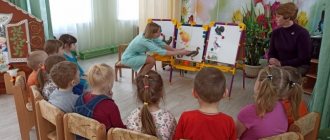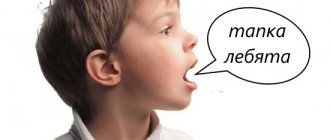Structure of a speech therapy lesson
Structure of a speech therapy lesson
The organizational and plot basis of classes can be very diverse. It all depends on the desire and capabilities of the teacher, his readiness for impromptu. Here are some options for organizing classes using:
- fairy tales;
- elements of folklore;
- imaginary journeys, excursions, trips, adventures;
- literary characters;
- famous and invented games;
- elements of a plot-didactic game;
- plot and landscape paintings;
- specially made drawings, collages, mosaics, panels;
- board and printed games;
- cartoon stories and characters.
It is not necessary to use only well-known plots and themes. You can come up with the entire plot yourself, or you can use the basis of the proposed plot and develop it during the lesson, if the possibilities of joint impromptu and creativity between the teacher and the children allow.
The structure of classes on automating pronunciation and differentiation of sounds includes the required elements:
1. Organizational moment.
2. Report the topic of the lesson.
3. Characteristics of sound based on articulatory and acoustic characteristics.
4. Pronunciation of the studied sounds in syllables and syllable combinations.
5. Pronunciation of sounds in words.
6. Physical education minute.
7. Work on pronunciation.
8. Pronunciation of sound in coherent speech.
9. Summary of the lesson.
Let us consider in more detail the tasks and options for organizing the structure of classes to automate pronunciation and differentiate sounds.
- Organizational.
His goal
– introduction to the topic of the lesson, creating a positive attitude, awakening interest in learning new sounds, as well as correction of psycho-speech functions.
The main task
of the teacher is to involve children in work from the first minutes of class. Organizational aspects are carried out in different ways, but in any case it is useful to include relaxation, facial expression and imitation exercises.
For example, a lesson on the topic “The abduction of the letter B
"begins with reading the telegram. In another version, a lesson based on the plot of “A Walk in the Woods” begins with a riddle. This is followed by relaxation exercises that help relieve increased muscle tension in children with dysarthria. The third option uses psycho-gymnastics. Facial exercises improve the functioning of the facial muscles and promote the development of mobility of the articulatory apparatus. You can use elements of psychogymnotics. Psycho-gymnastics helps children to emancipate, express their “I”, develop imagination, and overcome motor awkwardness.
2. Report the topic of the lesson.
The tasks offered in this part allow you to smoothly and imperceptibly move on to the topic of the lesson. Toys, flat figures or images of characters participating in the lesson are usually displayed in front of children. Children get to know them, highlight the sounds they are learning and the names of the characters.
For example, in the lesson “The Three Little Pigs,” the topic message reads like this: “Today we will compose a fairy tale about Nif-Nif, Naf-Naf, Nuf-Nuf and study the sounds
N, NH
. ” Another option: children are asked to repeat and guess a riddle, all the words of which contain the sounds being studied.
Thus, the playful form of communicating the topic of the lesson not only awakens children’s interest in the lesson, but also achieves the main thing for this stage - children’s attention is directed to the sound being studied, to the perception of new or repetition of sounds they have learned.
3. Characteristics of sounds according to articulatory and acoustic characteristics.
At this stage the following tasks are being implemented:
- articulation is clarified - the position of the lips, tongue and teeth when pronouncing the sound being studied;
- the sound “profile” is shown in the figure;
- the acoustic characteristics of sounds are clarified: consonants or vowels, hard or soft, deaf or voiced;
- there is a figurative comparison of sound (sound [R
] - roar of a tiger);
- their place in the sound-letter city is determined (they will live in the Blue, Red or Green castle).
4. Pronunciation of the studied sounds in words and syllable combinations.
The main task
is the development of auditory-verbal memory and phonemic perception, facial expressions and prosodic components of speech (rhythm, stress and intonation). The pronunciation of syllable series is usually combined with the development of intonation expressiveness of speech and facial expressions. Syllable combinations are pronounced by the character of the lesson.
5. Pronunciation of sounds in words.
At this stage of the lesson the following tasks are solved:
- development of phonemic awareness and phonemic representations;
- clarification and expansion of vocabulary;
- mastery of grammatical categories of inflection and word formation, comprehension of the meaning and ambiguity of words;
- development of auditory attention and visual memory;
- mastery of simple and complex types of sound-syllable analysis and synthesis.
To solve these problems, the selection of verbal and visual material is important. The first selection criterion is determined by the topic and plot of the lesson, the second - by the task. In work to enrich children's vocabulary and develop phonemic awareness, objects, toys and pictures must be displayed.
In the process of developing phonemic awareness, visual material is not demonstrated, and if it is displayed, it is only after children name words. Here, children's phonemic representations, based on previously known images of objects, make it possible to activate thought processes and develop memory in children.
The use of words in one lesson that include one or more generic groups (birds, animals, dishes, etc.) promotes the development of logical memory, and the use of speech material - words rich in the sound being studied (at the beginning, middle or end of the word) , develops sound sense.
In parallel with solving the listed problems, at this stage work is being done on mastering the grammatical categories of the language. Questions are posed in such a way that children can repeat one and the same word in different cases, singular and plural, in the present or past tense and with different prefixes.
The development of auditory attention is facilitated by verbal games “Sound Lost”, “Sound Got Lost”, as well as tasks to restore words with rearranged sounds, guessing words by the first and last sound and syllable and restoring mixed up syllables.
6. Physical education moment
The physical education minute is closely related to the topic of the lesson and is like a transition bridge to the next part of the lesson.
The main objectives of the physical education minute are:
- relieve fatigue and tension;
- add an emotional charge;
- improve gross motor skills;
- develop clear coordinated actions in conjunction with speech.
When planning a physical education moment, it is necessary to remember that outdoor games and physical exercises in combination with speech help improve gross motor skills. Exercises to simulate labor actions also serve this purpose. Music and rhythmic movements relieve fatigue well and have a beneficial effect on children's mood.
There are different forms of physical education minutes. This can be an outdoor game, an imitation of labor actions, the pronunciation of phrases accompanied by action, and much more. Sometimes the development of the plot in a physical education minute is connected by a situational chain with a word from the previous stage of the lesson. A physical education minute can also be carried out in the form of psychophysical gymnastics, when children use facial expressions, gestures and movements to depict the state of different animals.
Physical education minutes can be spent listening to music related to the topic of the lesson.
7. Work on the proposal.
Children's successful mastery of the patterns of necessary connections between words in sentences is facilitated by preliminary work on tasks on word combinations.
Establishing patterns in the assimilation of the necessary connections of words in combinations is the basis for the formation of lexical and grammatical constructions of sentences.
At this stage of classes the following tasks are solved:
- establishing lexical and grammatical relations between members of a sentence;
- updating the accumulated vocabulary;
- formation of coherence and clarity of statements;
- working on a sentence as a means of developing thought processes, in particular inferences;
- analysis and synthesis of the verbal composition of a sentence as a means of preventing written language disorders (dysgraphia, dyslexia).
The methods of working on a proposal are varied, but in any case it is necessary to remember that the tasks must comply with the basic didactic rule, from simple to complex. At the initial stage, these are answers to asked questions based on pictures. Then, the tasks become more complicated: children are asked to compose sentences using a set of words or reference words.
The creation of a lively and creative environment is facilitated by tasks in which in “unfortunate things” and “unprecedented things” you need to correct semantic errors intentionally made by the speech therapist.
A prerequisite when choosing principles and techniques for organizing tasks at this stage of work on a proposal should be a logical and playful connection with the plot of the lesson.
8. Pronunciation of sound in coherent speech.
The main part of the stage is improving the skill of correct pronunciation of sounds in connected texts, i.e. bringing the pronunciation of sounds to automaticity. Along the way, the following tasks
:
- development of imagination and creative imagination;
- development of word creation;
- development of melodic-intonation and prosodic components.
A necessary and mandatory condition for tasks at this stage is a semantic and playful connection with the topic or plot of the lesson and with the tasks of the previous stage.
The methods for the main and associated problems are varied. In some cases, tasks with well-known pure sayings and poetic works - dialogues and poems - are used. Moreover, it is necessary that they be saturated with the sounds being studied, be entertaining, accessible and diverse in intonation characteristics.
Tasks for composing phrases and poems contribute to the development of rhythm, a sense of consonance, and rhyme. Children usually enthusiastically accept the teacher’s request to compose or correct simple sayings or poems that for some reason the characters in the plot do not succeed in.
First they suggest individual words and rhymes, and then whole phrases. The development of coherent speech is facilitated by planned or impromptu construction of the plot of the lesson. As the lesson progresses, children predict the characters' actions, come up with dialogues and lines for them, answer questions and find a way out of problematic situations.
If time permits, you can arrange for children to retell fairy tales on behalf of the characters with possible theatricalization of actions (imitation of movements, acting out skits, etc.) developing as the plot progresses.
9. Summary of the lesson.
At the final stage, the results are summed up, i.e. its effectiveness is determined. A prerequisite is the transfer of positive emotions.
When making an individual assessment, it is necessary to note the activity, success, even if small, or simply the good mood of this or that child, and the reaction to failures should be with the hope of success in subsequent activities, with the conviction that there is no need to despair - if you work actively, everything will work out !
It is important to find out the children’s assessment of the past lesson in answers to the questions: “What did you like? What tasks did you find interesting? What was the most difficult task? What would you like to hear next time?” etc. The answers can find closer contact with children and select a successful principle for constructing tasks for each stage of subsequent classes.
The outcome of the lesson can be presented in a playful way, where a surprise is provided.
The final “chord” of the lesson should be a positive assessment and confidence that tomorrow you will do even better. It is important to end the lesson so that the children look forward to the next meeting with the speech therapist.




![Producing the sound [L] to a child in stages. Articulation gymnastics, speech therapy exercises, pronunciation lessons with pictures](https://doktorobrubov.ru/wp-content/uploads/postanovka-zvuka-l-rebenku-poetapno-artikulyacionnaya-gimnastika-logopedicheskie-uprazhneniya-uroki-330x140.jpg)

